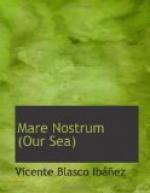The fauna of the abyssal depths where the lack of light makes all vegetation impossible, is largely carnivorous, the weak inhabitants usually devouring the residuum and dead animals that come down from the surface. The strong ones, in their turn, nourish themselves on the concentrated sustenance of the little cannibals.
The bottom of the ocean, a monotonous desert of mud and sand, the accumulated sediment of hundreds of centuries, has occasional oases of strange vegetation. These grove-like growths spring up like spots of light just where the meeting of the surface currents rain down a manna of diminutive dead bodies. The twisted limestone plants, hard as stone, are really not plants at all, but animals. Their leaves are simply inert and treacherous tentacles which contract very suddenly, and their flowers, avid mouths, which bend over their prey, and suck it in through their gluttonous openings.
A fantastic light streaks this world of darkness with multicolored shafts, animal light produced by living organisms. In the lowest abysses sightless creatures are very scarce, contrary to the common opinion, which imagines that almost all of them lack eyes because of their distance from the sun. The filaments of the carnivorous trees are garlands of lamps; the eyes of the hunting animals, electric globes; the insignificant bacteria, light-producing little glands all of which open or close with phosphorescent switches according to the necessity of the moment,—sometimes in order to persecute and devour, and at others in order to keep themselves hidden in the shadows.
The animal-plants, motionless as stars, surround their ferocious mouths with a circle of flashing lights, and immediately their diminutive prey feel themselves as irresistibly drawn toward them as do the moths that fly toward the lamp, and the birds of the sea that beat against the lighthouse.
None of the lights of the earth can compare with those of this abyssal world. All artificial fires pale before the varieties of its organic brilliance.
The living branches of polyps, the eyes of the animals, even the mud sown with brilliant points, emit phosphoric shafts like sparks whose splendors incessantly vanish and reappear. And these lights pass through many gradations of colors:—violet, purple, orange, blue, and especially green. On perceiving a victim nearby, the gigantic cuttle-fishes become illuminated like livid suns, moving their arms with death-dealing strokes.
All the abyssal beings have their organs of sight enormously developed in order to catch even the weakest rays of light. Many have enormous, protruding eyes. Others have them detached from the body at the end of two cylindrical tentacles like telescopes.
Those that are blind and do not throw out any radiance are compensated for this inferiority by the development of the tactile organs. Their antennae and swimming organs are immeasurably prolonged in the darkness. The filaments of their body, long hairs rich in nerve terminals, can distinguish instantaneously the appetizing prey, or the enemy lying in wait.




